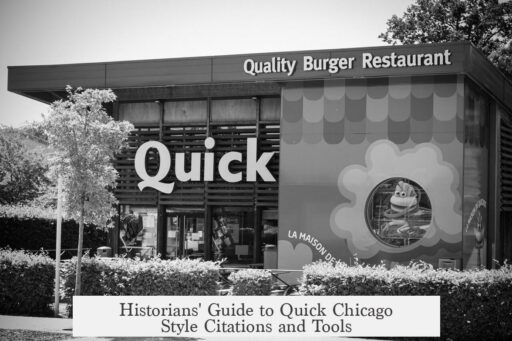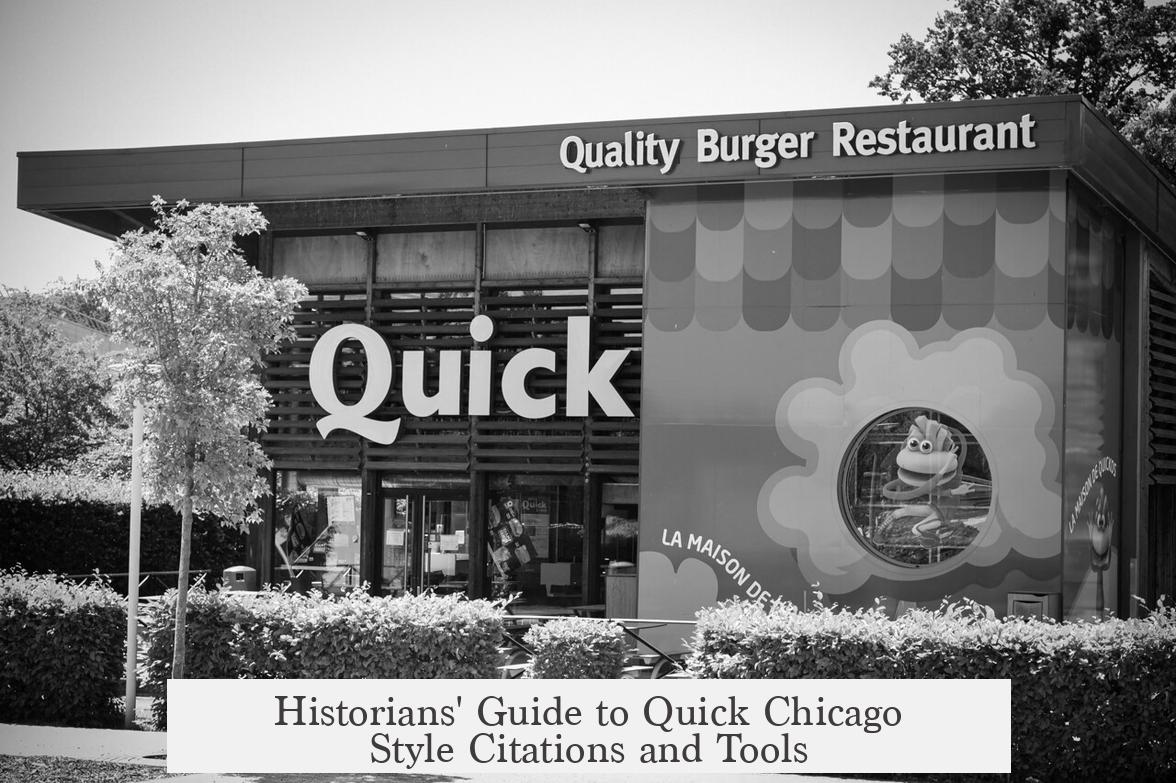Historians seeking quick Chicago style citations often turn to automated citation generators and reference management tools, but they balance speed with accuracy by verifying outputs against style manuals.

For rapid citation needs, websites like CitationMachine.net and BibMe.com provide fast formatting. These tools supply quick drafts of Chicago-style citations, saving time during early research stages or tight deadlines.
Despite their convenience, automated sites have limits. Their citations often require manual correction to fully adhere to Chicago standards, especially in footnotes. Historians recognize that relying solely on these can lead to errors or inconsistencies.

Many scholars prefer reference management programs such as Zotero, Mendeley, EndNote, or RefWorks. These tools not only format citations but help manage research libraries, notes, and bibliographies efficiently. Zotero stands out as a free and widely adopted option.
Some historians use personalized or improvised citation systems tailored to their workflow, like Google Forms and Sheets. This reflects diverse preferences and illustrates that there is no single universal method.

Importantly, understanding Chicago style firsthand remains critical. Mastery of the Turabian Manual for Writers or the Chicago Manual of Style ensures citations meet academic and publication standards. This skill aids historians in interpreting bibliographies and creating citations for nontraditional sources not well handled by software.
Key takeaways:

- Automated citation sites offer quick, rough Chicago style citations.
- Reference management tools enhance citation accuracy and bibliographic control.
- Historians often customize citation workflows to suit personal preferences.
- Manual verification against Chicago style guides is necessary for quality and compliance.
- Learning citation style early benefits research and writing skills long-term.
Is There an Easy Place That Historians Use for Quick Chicago Style Citations?
Yes, historians often begin with automated citation websites for quick Chicago style citations, but they rarely stop there. These online tools certainly provide fast results when deadlines loom or when the paper’s just a minor assignment. However, seasoned historians know the journey doesn’t end at a click — they dive deeper into reference managers and manuals to keep citations polished and precise.

If you’ve ever wrestled with Chicago style footnotes or bibliographies, you’re not alone. The system offers depth and nuance that can overwhelm beginners. The question: Is there an easy place historians use to get those citations out in record time without sacrificing accuracy? Let’s unpack the real deal.
Quick Fixes: The Allure of Automated Citation Websites

Back when citation styles first felt like an unsolved Rubik’s cube, tools like citationmachine.net and bibme.com emerged as digital lifesavers. Many students and historians use them to crank out citations in seconds, especially for short papers or last-minute projects.
These sites offer simple interfaces: plug in your source info, select Chicago style, and voilà—seconds later, a citation appears ready for paste. One could almost say they’re the “fast food” of bibliographies—quick, convenient, but not necessarily gourmet.
That’s not to diminish their value. For quick reference or less formal assignments, automated citation tools are a great starting point. They reduce grunt work and help newcomers familiarize themselves with citation elements. They also make it easy to handle standard book or journal citations.
The Catch: Limits of Automated Citation Tools
Here’s the kicker: these citation machines aren’t flawless. They often glitch on less straightforward sources like podcasts, web documentaries, or even rolling updates from apps. This happens because the Chicago style guide provides specific formatting rules for different media types—something AI-generated forms can miss.
Historians know that errors creep in: misplaced commas, incorrect italics, or omitted page numbers. If you rely solely on these tools, be prepared to put on your editor hat. For projects that truly matter, no shortcut replaces a careful manual review.
So, while automated citation sites might spit out your bibliography fast, they miss out on the critical nuances. Anyone seriously invested in historical research needs to go beyond instant citation generation.
The Power of Learning Manual Citation
Why bother learning to do citations by hand? It’s more than tradition or headache avoidance. Being able to read and craft citations confers real advantages:
- You can decipher other bibliographies to discover new sources or verify references.
- You understand how to cite unconventional materials that machines stumble over.
- You gain confidence in your citations’ accuracy and presentation.
Starting with manual citation in short assignments builds a foundation, making comprehensive Chicago style fluency less daunting. It’s the historian’s secret weapon for credible work.
Reference Managers: The Modern Historian’s Swiss Army Knife
So, where do historians turn when they want to avoid the citation chaos but need serious accuracy? Enter the reference management tools.
Programs like Zotero, RefWorks, Mendeley, and EndNote are favorites. They do much more than generate citations on demand.
Think of them as the digital librarians of your research: they gather sources, auto-format citations in Chicago style, and organize bibliographies. They remember your settings across documents, and many allow easy collaboration, which is a huge plus when team members are involved.
Out of the bunch, Zotero stands out for being free and highly user-friendly. Many historians recommend it for beginners and experienced scholars alike. It integrates with word processors, ensuring your footnotes and bibliography update in real time as you write.
Personal Tweaks: Custom Citation Solutions
Believe it or not, some historians craft their own bespoke citation systems. For instance, one historian shares using a homemade reference manager built through Google Forms and Sheets — a tool born out of familiarity and frustration with commercial options like RefWorks.
This highlights a key lesson: the best citation tool often depends on personal comfort and workflow compatibility. If you find a method that works and feels intuitive, whether a premium tool or a DIY solution, you’re more likely to keep your citations clean and consistent.
Still, Always Check the Manual
Regardless of the tool you pick, the absolute golden rule is: double-check your citations against the authoritative Chicago style manual.
For historians, that’s typically Turabian’s Manual for Writers of Research Papers, Theses, and Dissertations. Professors and editors often weigh citation formatting just as heavily as the content itself, so don’t risk missing a comma that could cost you points or credibility.
Think of citation manuals as the ultimate referee in the bibliography game. Your fancy software will get close, but the manual will keep it fair and square.
So, What’s the Verdict?
Do historians have one easy place for quick Chicago citations? Not exactly. Here’s the rundown:
- For speed and simplicity, automated sites like citationmachine.net and bibme.com are handy.
- For serious work, they fall short and require manual editing.
- Most scholars prefer reference management tools like Zotero for efficiency, accuracy, and robust bibliography control.
- Some researchers customize their own systems for ease and familiarity.
- No matter the tool, double-check citations against Turabian’s manual.
So next time you’re wrestling with Chicago style citations, remember: quick shortcuts exist, but mastering the style through practice—and reliable tools—makes you a citation ninja in no time.
What’s been your experience? Have you relied on automatic citation sites or gone full manual? Share your tips below and help fellow history buffs conquer the citation beast.
Q1: Are automated citation websites good for quick Chicago style citations?
Yes, sites like citationmachine.net and bibme.com offer fast citation generation. They help with quick drafts or initial work. However, these tools often need you to correct errors later.
Q2: Do professional historians rely only on automated citation tools?
No, automated tools are limited for advanced research. Historians usually combine these with manual checking and more robust reference managers for accuracy.
Q3: What do historians use besides citation websites for Chicago style citations?
Most use reference managers like Zotero, RefWorks, Mendeley, or EndNote. These programs format citations automatically and help organize large bibliographies effectively.
Q4: Why should students learn to create Chicago citations manually?
Knowing manual citation helps you understand the style better and handle unusual sources. It also prepares you for checking and fixing errors in automated citations.
Q5: Is it important to check citations against a style manual?
Yes. Professors often care about precise formatting. Always compare auto-generated citations to manuals like Turabian’s to ensure correctness, especially on important papers.
Q6: Can personal or homemade reference tools be useful?
Definitely. Some users make custom systems, like using Google Forms and Sheets. These can be easier if you know them well and need tailored solutions.




